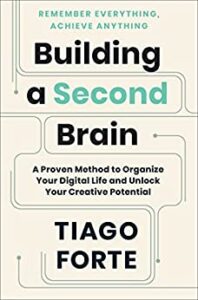 I took a while to get through this book — Building a Second Brain by Tiago Forte — but that is much more about me than about the book. I had to take a break from reading it, and it turned out that having that break, I came to appreciate some things about it even more. It’s worth rereading, to help hone some of the skills and habits over time. There’s also a certain amount of sifting, trying on, and deciding what works for you the individual, over time, because really there’s something here for everyone, but each person is likely to use it a bit differently.
I took a while to get through this book — Building a Second Brain by Tiago Forte — but that is much more about me than about the book. I had to take a break from reading it, and it turned out that having that break, I came to appreciate some things about it even more. It’s worth rereading, to help hone some of the skills and habits over time. There’s also a certain amount of sifting, trying on, and deciding what works for you the individual, over time, because really there’s something here for everyone, but each person is likely to use it a bit differently.
I can think of many areas of my life where I can use the methods set out here, in different ways. As a blogger, to keep track of ideas, links, and research for articles; as a fiction writer to help me keep track of ideas and research for stories, as well as articles about writing as craft; as a knitter to help me track the great variety of resources, patterns, ideas and skills that accumulate in a knitting life. And for personal purposes to help me keep track of all those snippets of information that feed into keeping house, keeping healthy, and keeping financially on top of things. I tend to be something of a hoarder with information, and I’m hoping the skills I learn from this book will help me keep only what I need, in more usable forms.
There are some parts of the book that I want to go back over right now, and take some notes, because I know I need to learn how, for instance, to recognize what really resonates with me and to distill my notes better, as well as how to align all my filing systems (paper and digital) and make that alignment a habit.
This is a system well worth trying, in whatever way fits the user best. I’m sure that over time how one uses it will change as well, because life keeps changing, and our goals and the types of projects we take on morph and shift through a lifetime.
What Building a Second Brain teaches, basically, is how to keep a digital (or paper where you prefer it) commonplace book. Collecting “commonplaces” or keeping a commonplace book is a practice that’s been around for hundreds if not thousands of years. But this book’s methods bring that practice into the digital era, and the age of the internet, where we have a virtual storm of information available to us. It’s a system for keeping track of all the information worth keeping that flows into and out of one’s life in such a way that the essence of what’s important in that flood of data remains accessible for when we need it most. The point of the title is that instead of needing to keep all that information in your memory, you keep only what resonates, and in a distilled format. You use external systems to keep track of it that enable you to return to it or be reminded of it when it counts. This frees up your real (first) brain, to allow you to be creative and live your life.
I’ve tended to be a hoarder of information, but I’ve had no really streamlined way of tracking all of that information and remembering where it is when I need it, so these are valuable skills that may save me a lot of time and headache in the long run. But I think that each person who uses this system will naturally refine it and find their own best way, so I think of this as a recipe more than a detailed how-to, and while there’s a lot to be found here by way of a detailed system, it’s best to play with it and find how it works best for yourself and your own life.